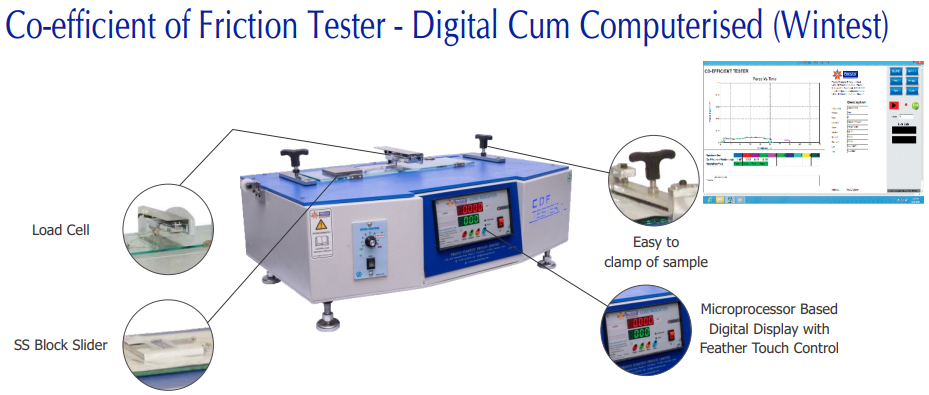

When it comes to the packaging industry, aspects like grip and slip carry a significant weightage. For any materials, such as films, papers, laminates, the slip and grip properties are essential. Why? These properties affect how packaging behaves during production, filling, transportation, and handling. If the packaging surface is too slippery, stacks of films or cartons may slide uncontrollably, leading to jams in machines or accidents during shipping. On the other hand, if the packaging is too sticky, it can cause feeding issues, tearing, or delays in high-speed packaging lines. For these reasons, in this industry, a coefficient of friction tester is required.
Why do you exactly need a COF tester? Yes, it measures the grip and slip properties. But how is it relevant? Think of it like a pair of shoes. If the insole and outer sole are too slippery, you will break some of your bones while walking. On the other hand, if these are too grippy, there is a high chance to face some accidents. In both cases, it’s your loss. The coefficient of friction tester acts just like that inspector that measures two essential aspects:
Static friction: Indicates the initial resistance to movement
Kinetic friction: Measures the resistance during motion
With a CAGR of 11.46%, packaging industry in India is around USD 20.41 billion. By 2031, it is projected to reach at $31 billion. So, now you understand how important it is to check the friction in the packaging materials. What are the materials used for packaging around India? Paper, films, cardboard, glass, etc. are generally used. And it's not only limited to the packaging industry, but also to the coating and textile industry as well. Without proper evaluation, films may stick to each other, jam in machines, or slip excessively during stacking and transportation. By testing surface friction by the friction testing machine, manufacturers can determine the correct balance required for smooth operations on high-speed packaging lines. This ensures both efficiency and safety, while reducing costly downtime caused by packaging failures.
The static and kinetic friction test is one of the most significant assessments to evaluate the material quality. As mentioned earlier, the static test measures the force required to initiate movement between two surfaces, while the kinetic test tracks the resistance during sliding. The static and kinetic friction test is important to decide whether packaging films or papers will feed smoothly through machines or hold securely when stacked. Any kind of imbalance can lead to problems such as poor sealing, tearing, or slippage, which compromise product safety.

Industries that rely on plastic and laminated films such as food packaging, cosmetics, pharmaceuticals, e-commerce, agricultural, automotive, etc. widely use the film friction tester. For instance, in food packaging, films must not be too slippery, or they could slide apart, exposing the contents. On the other hand, in the agricultural industry, the film should be tightened enough while packing the seeds so that those neither fall off nor get damaged during raining or under direct sunlight. The film friction tester helps in adjusting film compositions, coatings, and finishes so that they meet industry performance standards.
Similar to the other tests in this paradigm, the packaging friction test also provides vital insights into how materials behave in real-world conditions. It allows manufacturers to simulate the forces that occur during transportation, stacking, and sealing. For example, cartons and wrappers must withstand vibrations and pressure without sliding out of place. This test helps packaging companies reduce product losses, prevent accidents, and enhance customer satisfaction. In simplest terms, the packaging friction test provide safer handling of products.
When it comes to determine static and kinetic coefficients of friction of plastic films and sheeting, the ASTM D1894 Standard is the most widely acknowledged procedure. The procedure involves:
COF = Measured Force ÷ Weight of the sledStatic COF value Kinetic COF value Test conditions (temperature, humidity, film type, thickness)Paper friction test in printing and converting checks smooth machine runs, prevents paper jams, and avoids ink smudging or misalignment. By selecting paper with the right slip and grip, manufacturers reduce downtime, minimise waste, and improve product quality. This efficiency lowers costs, boosts productivity, and increases profitability.
To determine how packaging films interact with one another during production and use, running the plastic film coefficient of friction is necessary. Factors such as additives, coatings, and surface treatments can alter these friction values. By measuring them accurately, companies can fine-tune film properties for applications like shrink wraps, bags, and laminates.
Q1: How does friction testing benefit the paper and film industries?
A: It determines smoother machine operations, reduces product loss, and guarantees consistent material quality for packaging applications.
Q2: Why is a Coefficient of Friction Tester important for packaging materials?
A: It helps manufacturers measure slip and grip values to ensure films and papers function correctly during processing, transportation, and storage.
Q3: How much does a Coefficient of Friction Tester cost?
A: A COF tester, depending on its features, usually costs in between Rs 75,000 and Rs 205,000.
Looking for the best COF Tester Price? Presto Group offers advanced Coefficient of Friction Testers at competitive rates to ensure precise quality testing. Get expert guidance and unbeatable deals today. Call us at +91 9210 903 903 or mail at info@prestogroup.com to request your quote!
Related Blogs

Learn common UTM testing errors, their causes, and techniques to improve accuracy through calibration, alignment and training.

Achieve accurate inspection of automotive and aerospace components using optical profile projectors. Improve quality control and precision.

Protect medicine & pharma products with precise vacuum leak testing. Boost quality & trust – Get your tester today!